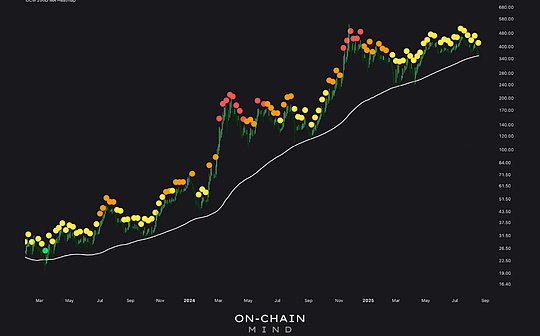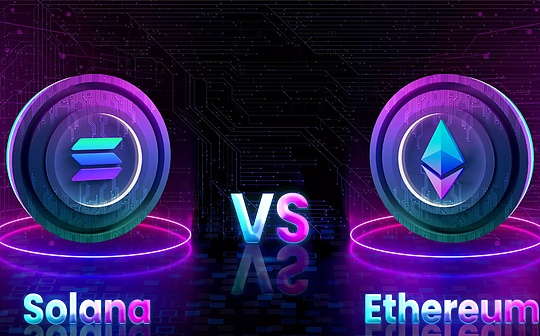
Author: Lawrence Lee
After receiving two consecutive rounds of financing, including a $12 million funding led by Polychain and a Binance labs financing, Solana’s resting project, Solayer, has become one of the few highlights in the DeFi field in the market recently, and its TVL continues to rise.Already surpassed Orca and ranked twelfth on the Solana chain TVL.
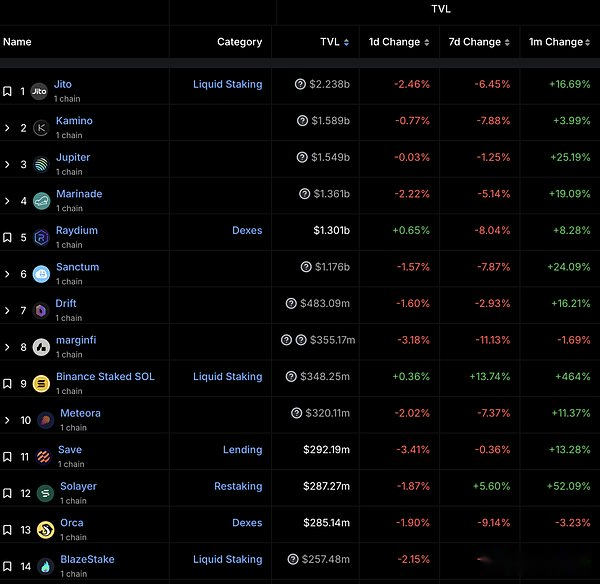
Solana Project TVL Ranking Source: DeFillama
The pledge track is a crypto-native sub-track track and is also the largest crypto track in TVL. Its representative tokens LDO, EIGEN, ETHFI, etc. have struggled very much in this cycle, putting aside the Ethereum network they are in.Besides, are there any other reasons?
-
How competitive are the staking and resting agreements surrounding user staking behavior in the entire staking ecosystem?
-
How is Solayer’s resting different from Eigenlayer’s resting?
-
Is Solayer’s resting a good business?
I hope this article can answer the above questions.Let’s start with staking and resting of the Ethereum network.
The competitive situation and development pattern of Liquid Staking, Restaking, and Liquid Restaking on the Ethereum Network
In this section we will mainly discuss and analyze the following items:
The head of the Ethereum network liquid staking project Lido, the head resting project Eigenlayer and the head of the liquid resting project Etherfi.
Lido’s business logic and revenue composition
Regarding Lido’s business logic, we briefly describe it here:
Due to Ethereum’s insistence on decentralization, ETH’s PoS mechanism softly limits the staking limit of a single node. Only by deploying a maximum of 32 ETHs in a single node can you obtain higher capital efficiency. At the same time, the staking has relatively high hardware.Due to network and knowledge requirements, the threshold for ordinary users to participate in ETH staking is high.Against this background, Lido has carried forward the concept of LST.Although LST’s liquidity advantage was weakened after Shapella’s upgrade to open withdrawals, LST’s advantages in capital efficiency and composability remain solid, which constitutes the basic business logic of the LST protocol represented by Lido.In the liquid staking project, Lido’s market share is close to 90%, leading the market.
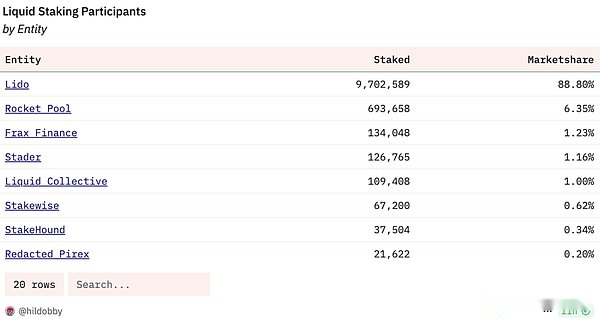
Liquid staking participants and market share Source: Dune
The revenue from the Lido protocol comes mainly from two parts: consensus layer earnings and execution layer earnings.The so-called consensus layer income refers to the increase in PoS issuance of Ethereum network. For Ethereum network, this part of the expenditure is paid to maintain network consensus, so it is called consensus layer income. This part is relatively fixed (the figure belowThe orange part); and the execution layer income includes the priority fees paid by the user and the MEV (Analysis of the execution layer income, readers can go to Mint Ventures for more information in the previous article). The income of this part is not paid by the Ethereum network, but byUsers pay (or pay indirectly) during the transaction execution process, and this part changes with the popularity on the chain and fluctuates greatly.
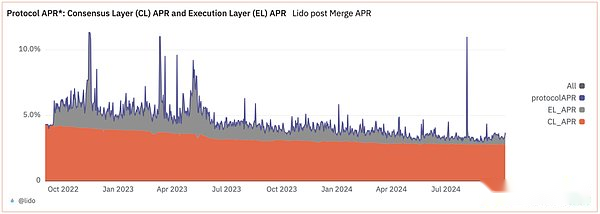
Lido Protocol APR Source: Dune
Eigenlayer’s business logic and revenue composition
The concept of Restaking was proposed by Eigenlayer last year and has become a rare new narrative in the DeFi field and even the entire market in the past year. It has also created a series of projects with FDV of more than 1 billion US dollars when it was launched (in addition to EIGEN, there are ETHFI, REZ andPENDLE), as well as many restaking projects that have not yet been launched (Babylon, Symbiotic and Solayer we will focus on discussing below), the market popularity can be seen (Mint Ventures once conducted research on Eigenlayer last year, and interested readers can go and check it out).
By its definition, Eigenlayer’s Restaking refers to a user who has staked ETH, which can restake ETH in Eigenlayer (to obtain excess returns), and therefore named ‘Re’Staking.Eigenlayer names the service it provides AVS (Actively Validated Services, literally translated as “active verification service” in Chinese), and can provide services for various security-required protocols, including side chains, DA layers, virtual machines, and oracles., bridge, threshold encryption scheme, trusted execution environment, etc.EigenDA is a typical example of using the EigenlayerAVS service.
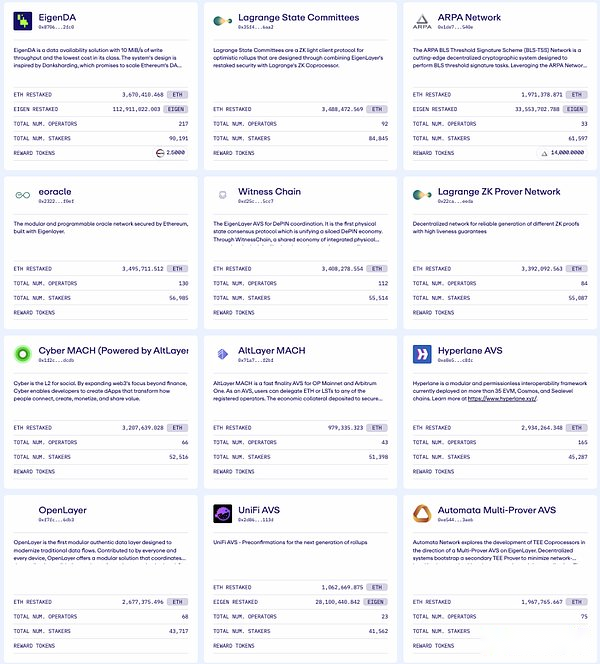
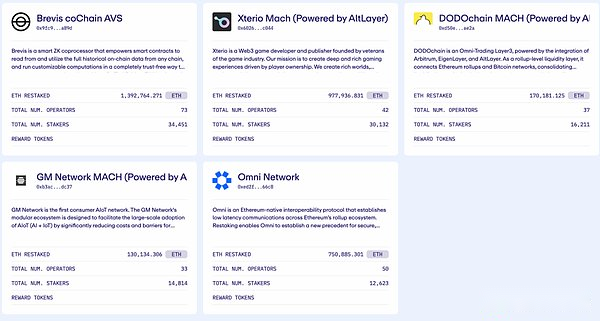
Currently using Eigenlayer AVS protocol Source: Eigenlayer official website
Eigenlayer’s business logic is also relatively simple. On the supply side, they raise assets and pay fees from ETH staker; on the demand side, agreements with AVS demand pay for their services, and Eigenlayer uses its services as the “protocol security market” to match and earn a certain amount of money.cost.
However, when we look at all the resting projects at present, the only real income is still the tokens (or points) of the relevant agreement. We are not sure that resting has obtained PMF: from the supply side, everyone likes the additional benefits brought by resting;But the demand side is still a fog: Is there really an agreement to purchase economic and security services for agreements?If so, how many would there be?
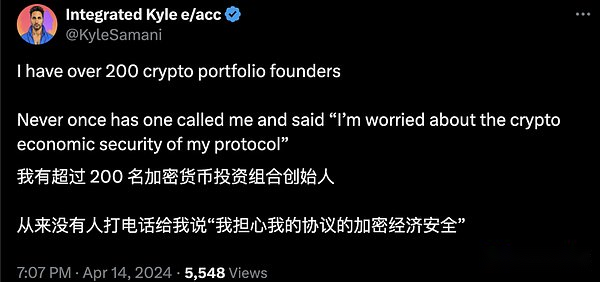
Multicoin founder Kyle Samani’s questions about resting business model Source: X
From the perspective of Eigenlayer’s target users who have issued coins: oracles (LINK, PYTH), bridges (AXL, ZRO), DA (TIA, AVAIL), pledging tokens to maintain protocol security are the core use cases of their tokens.Choosing to purchase security services from Eigenlayer will greatly undermine the rationality of its token issuance.Even Eigenlayer itself, when explaining EIGEN tokens, expressed the view that “using EIGEN to maintain protocol security” is the main use case in very abstract and obscure language.
Liquid restaking (Etherfi)’s Way to Survive
Eigenlayer supports two ways to participate in resting: using LST and native resting.The way to participate in Eigenlayer Restaking using LST is relatively simple. After the user deposits ETH in the LST protocol and obtains LST, he can deposit the LST into Eigenlayer. However, the LST pool has a long-term limit. Users who want to participate in resting during the limit period need to be native as followsresting:
-
First, users need to complete the entire process of pledging on the Ethereum network by themselves, including fund preparation, execution layer and consensus layer client configuration, setting withdrawal vouchers, etc.
-
The user creates a new contract account called Eigenpod in Eigenlayer
-
The user sets the withdrawal private key of the Ethereum pledge node to the Eigenpod contract account.
It can be seen that Eigenlayer’s Restaking is a relatively standard ‘re’s staking. Whether the user deposits other LSTs into Eigenlayer or native resting, Eigenlayer does not directly “contact” the user’s pledged ETH (Eigenlayer does not issue anyLRT).The process of Native restaking is a “complex version” of ETH’s native staking, which means similar thresholds for capital, hardware, network and knowledge.
Therefore, projects such as Etherfi quickly provided Liquid Restaking Tokens(LRTs) to solve this problem. Etherfi’s eETH operation process is as follows:
-
The user deposits the ETH into Etherfi, and Etherfi issues eETH to the user.
-
Etherfi pledges the received ETH, so that the basic income of ETH staking can be obtained;
-
At the same time, they set the node’s withdrawal private key to the Eigenpod contract account according to Eigenlayer’s native restating process, so that they can obtain Eigenlayer’s resting income (as well as $EIGEN, $ETHFI).
Obviously, the services provided by Etherfi are the optimal solution for users who hold ETH and want to make profits: on the one hand, eETH is simple to operate and has liquidity, which is basically the same as Lido’s stETH experience; on the other hand, users will use ETH.By depositing it into Etherfi’s eETH pool, you can get: about 3% of the basic ETH staking income, Eigenlayer’s possible AVS income, Eigenlayer’s token incentives (points), and Etherfi’s token incentives (points).
eETH accounts for 90% of Etherfi TVL, contributing more than $6 billion in TVL at its peak and FDV up to $8 billion, making Etherfi the fourth largest pledged entity in just half a year.
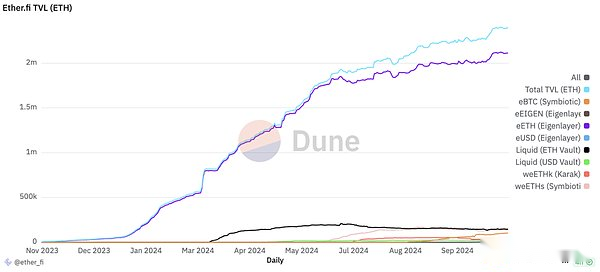
Etherfi TVL Distribution Source: Dune
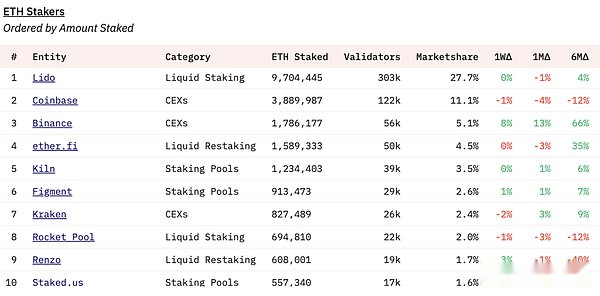
Pledge volume ranking Source: Dune
The long-term business logic of the LRT protocol is to help users participate in staking and resting in a simpler way, thereby achieving higher returns.Since it does not generate any profit itself (except its own token), in overall business logic, the LRT protocol is more similar to ETH’s specific income aggregators.If we analyze it carefully, we will find that the existence of its business logic is based on the following two premises:
-
Lido cannot provide liquid resting services.If Lido is willing to “imitate” eETH, Etherfi will be hard to match its long-term brand advantages, security endorsement and liquidity advantages.
-
Eigenlayer cannot provide liquid staking services.If Eigenlayer is willing to directly absorb users’ ETH to pledge it, it will greatly weaken Etherfi’s value proposition.
From the perspective of pure business logic, Lido, as the head of liquid staking, provides users with liquid restaking services to provide users with a wider source of income. Eigenlayer directly absorbs user funds and makes it more convenient to stake & restaking is completely feasible.Then why doesn’t Lido do liquid resting, and Eigenlayer do liquid resting?
The author believes that this is determined by Ethereum’s special circumstances.Vitalik In May 2023, Eigenlayer just completed a new round of $50 million financing. As a result, it has caused a lot of discussion in the market, it specifically wrote “Don’t overload Ethereum’s consensus” (Don’t overload Ethereum’s consensus) to use a series of examplesHe elaborated in detail on how Ethereum consensus should be reused (that is, “how should we restate”).
In Lido, since its scale accounts for about 30% of Ethereum pledge proportion for a long time, the Ethereum Foundation has been restricting it. Vitalik has also written articles to discuss the issue of pledge centralization many times, which has forced Lido to “Aligning with Ethereum” as its business focus, it not only gradually shut down all other chain businesses, including Solana, except Ethereum. Its de facto leader Hasu posted a statement in May this year to confirm that he would give up his restaking business.The possibility of limiting Lido’s business to staking, instead of investing in and supporting the resting protocol Symbiotic, and forming a Lido alliance to deal with competition for its market share by LRT protocols such as Eigenlayer and Etherfi.
Reaffirm that stETH should stay an LST, not become an LRT.
Support Ethereum-aligned validator services, starting with preconfirmations, without exposing stakers to additional risk.
Make stETH the #1 collateral in the resting market, allowing stakers to opt into additional points on the risk and reward spectrum.
Lido’s position on restaking related matters Source
In terms of Eigenlayer, Ethereum Foundation researchers Justin Drake and Dankrad Feist were hired as consultants by eigenlayer very early. Dankrad Feist said that his main purpose of joining is to align “eigenlayer with Ethereum”, which may also be the native restaking of eigenlayerThe reason why the process is quite contrary to the user experience.
In a sense, Etherfi’s market space is brought about by the “distrust” of Lido and Eigenlayer by the Ethereum Foundation.
Analysis of Ethereum Pledge Ecological Agreement
Combining Lido and Eigenlayer, we can see that in the current PoS chain, there are three long-term sources of income around pledge behavior, in addition to the token incentives of related parties:
-
PoS underlying income, the native tokens paid by the PoS network to maintain network consensus.The yield of this part mainly depends on the chain’s inflation plan, such as Ethereum’s inflation plan is linked to the pledge ratio. The higher the pledge ratio, the slower the inflation rate.
-
Transaction sorting income, the fees that nodes can obtain during the transaction packaging sorting process, including the priority fee given by users, and the MEV benefits obtained during the transaction packaging sorting process, etc.The yield of this part mainly depends on the activity level of the chain.
-
The leasing income of pledged assets is to lease the assets pledged by the user to other protocols that need to be required, thereby obtaining the fees paid by these protocols. This part of the income depends on how many protocols with AVS requirements are willing to pay fees to obtain the security of the protocol.
On the Ethereum network, there are currently three types of protocols around staking:
-
The liquid staking protocol represented by Lido and Rocket Pool.They can only get the 1st and 2nd gains mentioned above.Of course, users can take their LST to participate in the Restaking, but for the protocol, they can only get 1 and 2 above.
-
Restaking agreement represented by Eigenlayer and Symbiotic.This type of agreement can only obtain the third type of profit mentioned above.
-
Etherfi and Puffer represent the liquid resting protocol.They can theoretically obtain all three of the above benefits, but they are more similar to “LST that aggregates resting returns”
Currently, the underlying income of ETH PoS is about 2.8% annualized, which means that as the pledge ratio of ETH increases, it gradually decreases;
The transaction sorting income has decreased significantly with the launch of EIP-4844, and has been around 0.5% in the past six months.
The base of leasing income of pledged assets is small and cannot be annualized. It is more important to rely on token incentives from EIGEN and associated LRT protocols to make this incentive considerable.
For the LST protocol, its revenue base is the number of pledges * rate of return on pledges.The amount of ETH pledges has reached nearly 30%. Although this value is still significantly lower than other PoS public chains, from the perspective of Ethereum Foundation’s decentralization and economic bandwidth, we do not want too much ETH to flow into the pledge.(See Vitalik’s recent blog post, the Ethereum Foundation once discussed whether to set the upper limit of ETH staking to 25% of the total); while the staking yield continues to decline, stabilizing at 6% from the end of 22, often obtaining 10The short-term APR of around % has dropped to only 3% now, and there is no reason to rebound in the foreseeable future.
For the above protocol tokens, in addition to being subject to the decline of ETH itself:
The market ceiling of Ethereum network LST has gradually become visible, which may be the reason for the poor performance of the token price governance based on LST protocols of LDO and RPL;
For EIGEN, resting protocols on other PoS chains, including BTC chains, are emerging, which basically limits Eigenlayer’s business to the Ethereum ecosystem, further reducing its AVS market size, which is not clear.Potential upper limit;
The emergence of the LRT protocol that was not expected (the FDV at the peak of ETHFI exceeded 8 billion, and the highest FDV of LDO and EIGEN in history) further “dilutes” the value of the above two in the pledge ecosystem;
For ETHFI and REZ, in addition to the above factors, the excessive initial valuation brought about by going online during the market boom is a more important factor affecting the price of their tokens.
Solana’s staking and resting
The operating mechanism of the liquid staking protocol of the Solana network represented by Jito is basically no different from that of the Ethereum network.But Solayer’s resting is different from Eigenlayer’s resting.In order to understand Solayer’s resting, we need to first understand Soalna’s swQoS mechanism.
Solana network’s swQoS (stake-weighted Quality of Service, stake-weighted service quality mechanism) officially took effect after a client version upgrade in April this year.The starting point of the swQoS mechanism is for the overall efficiency of the network, as the Solana network experienced a long period of network lag during the meme boom in March.
Simply put, after swQoS is enabled, block producers determine the priority of their transactions based on the pledge amount of the pledge. Stakers with x% pledge ratio in the entire network can submit up to x% transactions (about the specific mechanism of swQoSand the profound impact on Solana, readers can read Helius’s article).When swQoS is enabled, the transaction success rate of Solana network has increased rapidly.
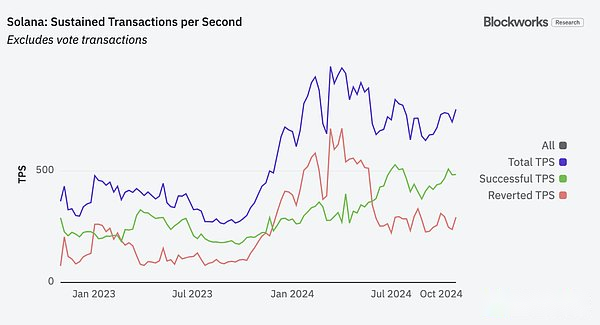
Solana Network Success and Failure TPS Source: Blockworks
swQoS “flooded” the transactions of small-value stakers in the network, so when network resources are limited, swQoS is given priority to guarantee the rights and interests of larger-value stakers in the network, thus avoiding malicious transactions attacks on the system.To a certain extent, “the more pledge ratio, the more network privileges you enjoy” is in line with the logic of PoS public chain: more proportion of chain native tokens are pledged, and the contribution to chain stability and chain native tokens will be more important.More, it is natural to enjoy more privileges.Of course, the centralization problem of this mechanism is also very obvious: larger pledgers can naturally obtain more priority trading rights, and priority trading rights will bring more pledgers, thus giving the advantages of the top pledgers the advantage ofSelf-reinforcement, further tend to oligopolist and even form monopoly.This seems to run contrary to the decentralization advocated by blockchain, but this is not the focus of this article. From Solana’s consistent development history, we can clearly find Solana’s “performance first” pragmatism in decentralization.manner.
In the context of swQoS, Solayer’s resting target users are not oracles or bridges, but protocols that require transaction passivity/reliability, typically like DEX.Solayer therefore calls the AVS services provided by Eigenlayer an exogenous AVS (Exogenous AVS), because these systems of the Eigenlayer service are usually located outside the Ethereum main chain.The services provided by oneself are called endogenous AVS (Endogenous AVS), because their service objects are located in the solana main chain.
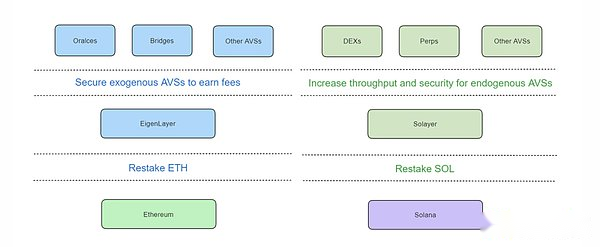
The difference between Solayer and Eigenlayer Source
It can be seen that although both leasing pledged assets to other required agreements to implement ‘re’staken stake, Solayer’s endogenous AVS and Eigenlayer’s exogenous AVS provide different core services.Solayer’s endogenous AVS is essentially a “transaction pass leasing platform”, which requires users to be a platform (or its users) that has a need for transaction pass leasing, while Eigenlayer is a “protocol secure leasing platform”.The core support of its endogenous AVS is Solana’s swQoS mechanism.As Solayer said in his documentation:
We did not fundamentally agree with EigenLayer’s technical architecture. So we re-architected, in a sense, restandardized resting in the Solana ecosystem. Reusing stake as a way of securing network bandwidth for apps. We aim to become the de facto infrastructure for stake-Weighted quality of service, and eventually, a core primitive of the Solana blockchain/consensus.
“We fundamentally disagree with EigenLayer’s technical architecture. So in a sense, we rebuild resting in the Solana ecosystem. Reusing Stake as a way to protect the APP network bandwidth. Our goal is to be swQoSDe facto infrastructure and eventually became the core primitive of Solana blockchain/consensus.”
Of course, if there are other protocols on the Solana chain that have pledged assets, such as protocol security requirements, Solayer can also lease its SOL to these protocols.In fact, any lease/reuse of a pledged asset can be by definition called re-staking without being limited to security requirements.Due to the existence of the swQoS mechanism of Solana chain, the resting business scope on the Solana chain is wider than on the Ethereum chain. Judging from Solana’s recent hot chain activity, the need for transaction passivity is greater than the need for security.More rigid.
Is Solayer’s resting a good business?
The business process for users to participate in Solayer resting is as follows:
-
The user directly deposits the SOL into the Solayer, and the Solayer issues sSOL to the user
-
Solayer pledges the received SOL, so that the basic pledge income can be obtained.
-
At the same time, users can delegate sSOL to agreements that require transaction pass rates, thereby obtaining the fees paid by these agreements.
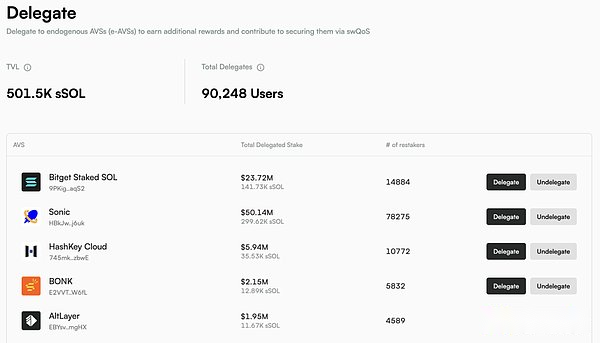
Current source of Solayer’s AVS
It can be seen that Solayer is not only a resting platform, but also a resting platform that directly issues LST. From the perspective of business processes, it is like Lido that supports native resting on the Ethereum network.
As mentioned above, there are three sources of income around pledge behavior. The three returns on Solana network are as follows:
-
PoS underlying income, Solana paid SOL in order to maintain network consensus, this part of the annualized income is around 6.5%, which part of the income is relatively stable.
-
Transaction sorting income, the fees that nodes can obtain during the transaction packaging sorting process, including the priority fee given by users to trade early, and the tips paid by MEV searcher. The two parts are about annualized.About 1.5%, but the change is large, depending on the degree of on-chain activity.
-
The leasing income of pledged assets is to lease the assets pledged by users to other agreements with demand (transaction passability, agreement security or other). This part has not yet reached a scale.

SOL liquid staking (taking JitoSOL as an example) total income and MEV income from APY
If we carefully compare the above three returns of Ethereum and Solana, we will find that although the market value of SOL is still only 1/4 of ETH and the market value of staked SOL is only about 60% of the market value of staked ETH, the staking related agreements of Solana chain are more than stakingThe staking-related agreements of the Ethereum chain have a de facto larger market and a larger potential market because:
1. In terms of PoS underlying income: The revenue from additional issuance of networks that SOL is willing to pay has been higher than ETH since December 23, and the gap between the two is still widening.Whether it is ETH or SOL staking, this accounts for more than 80% of its yield, which determines the revenue baseline of all staking-related agreements.

Ethereum and Solana tokens are added bonus (i.e., the network’s PoS underlying income) Source: Blockworks
2. Transaction sorting income: Blockworks uses transaction fees and MEV tips to reflect the real economic value of a chain (REV, Real Economic Value). This indicator can almost reflect the maximum transaction sorting income that a chain can obtain. We can seeAlthough the REVs in both chains have large fluctuations, Ethereum’s REV has dropped rapidly after the Cancun upgrade, while Solana’s REV has generally shown an upward trend and has successfully surpassed Ethereum in recent years.
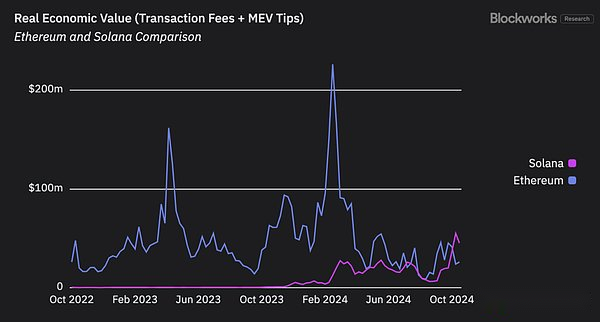
REVs from Solana and Ethereum Source: Blockworks
In terms of the rental income of pledged assets, compared with the Ethereum network, Solana’s swQoS mechanism can bring additional transaction passive rental needs.
Also, Solana’s staking-related agreements can expand its business according to business logic, and any liquid staking agreement can carry out resting business, such as Jito we see; any resting agreement can also issue LSTs, such as Solayer and Fragmetric.
More importantly, we have not seen any possibility of reversal in the above trend at present, that is, the advantages of the Solana staking agreement over the Ethereum staking agreement may continue to expand in the future.
From this perspective, although we can’t say that Solana’s resting has found PMF, it is clear that Solana’s staking and resting are better businesses than Ethereum.







